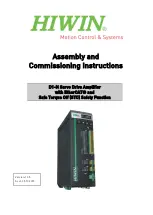
Doc Q7.0
47
TONESTACK TYPE
– The
BASS
,
MID
and
TREBLE
controls operate by default as “passive” controls. That is,
they simulate exactly the frequency and phase response of the classic passive tonestacks found in the original
amplifiers our simulations are based on.
The
TONESTACK TYPE
control lets you change this behavior from
PASSIVE to ACTIVE, or to substitute the passive tonestack of another amp type.
Selecting the “ACTIVE” type gives each tone c/- 12 dB boost/cut operation for up to twice the
range of a typical amplifier. Since the active tone controls are more sensitive, small adjustments have
bigger effects, and less extreme settings still achieve pretty extreme sounds. For example, full PASSIVE
treble for a high-gain British amp would be equivalent to only +5.0 dB ACTIVE, leaving 7 dB of additional
headroom! Active tone controls do not interact like those of a typical amplifier, so when you adjust the
treble, the mid and bass are not affected. This can make dialing in a certain tone easier and quicker than
it might be with a PASSIVE tonestack.
Selecting a substitute tonestack allows you to mix and match amps and tone stacks to create your own
hybrids. This allows you to use, for example, a Plexi-type tonestack on a Blackface amp model, or a
modern German tonestack in a British Preamp.
TONESTACK FREQ
– Sets the
center frequency
of the tone controls to determine their effect on the sound.
This control works whether you are using ACTIVE, PASSIVE, or substitute tone stacks.
This parameter defaults to an appropriate value whenever you change the amp
TYPE
, but it can then be
changed as desired. However, if you subsequently change the
TONESTACK TYPE
, the
TONESTACK FREQUENCY
will
not necessarily be correct anymore.
TONESTACK LOCATION
– This control lets you change the location of the tone stack. “PRE” places the
tone stack at the input to the preamp, “POST” places the stack between the preamp and power amp. “MID”
places it between the last two triode stages, and “END” places it after the power amp (which is physically
impossible with a real amp). Defaults to an appropriate value whenever you change the amp
TYPE
.
EQ TYPE
– This determines the number of bands for the amp block’s built-in graphic equalizer (from 3 to 8)
and whether it will be variable Q, constant Q, passive or console type.
PRESENCE FREQ
– This multiplier alters the center frequency of the amp’s
PRESENCE
control, which is
naturally determined based on the current selection for amp
TYPE
.
DEPTH FREQ
– Alters the center frequency of the amp’s
DEPTH
and
DYN DEPTH
controls. This parameter
defaults to an appropriate value whenever you change the amp
TYPE
, but can then be changed as desired.
POWER AMP BIAS SHIFT
– Controls the amount of phase inverter bias shift. Note that some real amps
are “spitty” in nature due to PI bias shifting, and the new algorithm is designed to replicate that behavior
accurately. If you find this undesirable reduce
PI BIAS SHIFT
as desired although this will reduce authenticity.
POWER AMP GRID BIAS
– (aka “Power Tube Bias”) Sets the bias point of the virtual power amp. Lower
values approach pure Class-B operation. Higher values approach pure Class-A operation.
POWER AMP GRID BIAS
– Sets the bias point of the virtual power amp. Lower values approach pure
Class-B operation. Higher values approach pure Class-A operation.















































